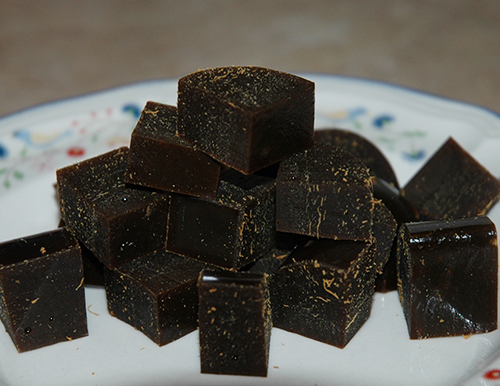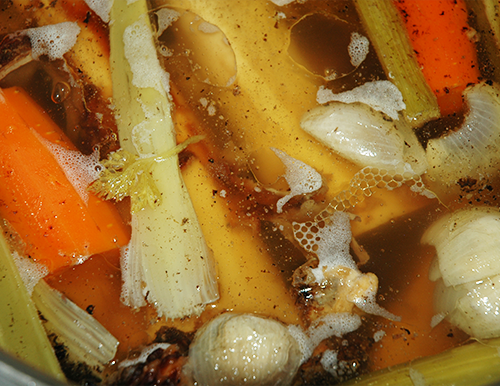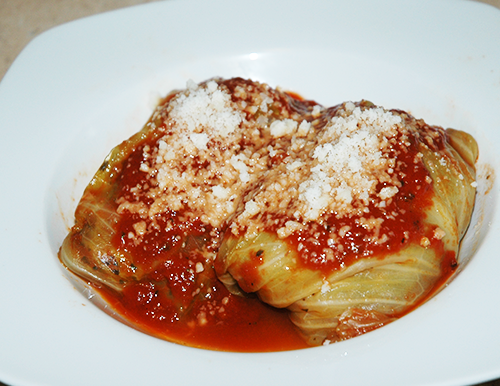Jump to Ingredients – Jump to Method – Jump to Printable Version
 In my last article I shared my recipe for beef stock. Now I am going to tell you how to turn that beef stock into handy stock cubes that you can make and use instead of store bought stock (or bouillon) cubes. This is the perfect solution if you have extra stock that you are not going to use right away. Sure, you can just freeze the liquid stock in ice cube trays and have a ton of frozen stock cubes. I do this all the time as well! They have their uses for sure. But making the kind of cubes that I am making in this article has benefits also.
In my last article I shared my recipe for beef stock. Now I am going to tell you how to turn that beef stock into handy stock cubes that you can make and use instead of store bought stock (or bouillon) cubes. This is the perfect solution if you have extra stock that you are not going to use right away. Sure, you can just freeze the liquid stock in ice cube trays and have a ton of frozen stock cubes. I do this all the time as well! They have their uses for sure. But making the kind of cubes that I am making in this article has benefits also.
There is no water in them, so your cooking is not diluted when you add them. Sometimes you want to add water, sometimes you don’t. When you don’t, use these!
They last practically forever in the freezer and never EVER get freezer burn, unlike frozen liquid stock. I have a suspicion that they would be safe to store at room temperature (since they are solid at room temperature, and actually are the same texture frozen or room temperature), but I am not going to try it until a food safety expert verifies my suspicion. Anyway, they take up very little room in the freezer so it is no problem to tuck them in there wherever you can, even if your freezer is packed full. Frozen liquid stock cubes take up a lot more room.
These stock cubes naturally contain no salt, unlike their store bought counter parts. This, I find desirable because then you can control the salt content in your cooking more easily. They also dissolve much more easily, removing any possibility that there will be a big salty chunk of “flavour” lurking in your dish waiting to surprise who ever is unfortunate enough to spoon it up. They also add gelatin to your dish, which is always desirable for it’s health benefits as well as the richness it adds to the texture of the food.
You can make these with whatever amount of leftover stock you have, though around 2 cups is probably about the minimal amount that would be worth the trouble. I do not usually use a whole batch of stock, but I made the last batch of beef stock specifically for this purpose. It was about 2 quarts worth and I ended up with 16 approximately teaspoon sized stock cubes.
Sunday
Apr 14, 2013
Jump to Ingredients – Jump to Method – Jump to Printable Version
 Oh the simple pleasures! I love making stock! The simplicity, the aromas, the usefulness of the finished product, it is all such a delight. Anyone who has ever made real, homemade stock will probably agree that store bought stock is a joke. It cannot possibly compare to this glory.
Oh the simple pleasures! I love making stock! The simplicity, the aromas, the usefulness of the finished product, it is all such a delight. Anyone who has ever made real, homemade stock will probably agree that store bought stock is a joke. It cannot possibly compare to this glory.
Beef stock is the second most frequent stock that I make. For me it is a little less convenient than chicken stock, since I often buy whole chickens and, therefor always have a supply of chicken bones and cuttings with which to make stock. Beef stock requires beef marrow bones, which I have to actually buy special. Now, there are some cuts of beef that include bones, and some of them even have marrow in them (like Beef Chuck Arm Steak). If you use these cuts of beef often and save the bones, then you can make your stock with those. Since I do not, however, I must buy my bones from the butcher. So I make it a little less often, but one of the things that I absolutely love about making beef stock is that the marrow bones render so much fat! I get five times the fat out of one batch of beef stock than I do out of a batch of chicken stock. Remember, stock is not the only thing you get out of making stock. That fat is just as valuable! Lately I have been more careful about the chicken that I use, and I have found that healthier chickens have much less fat than typical grocery store chickens, and their fat has a different quality. Typically, chicken fat, when cooled, has a texture similar to butter (ditto with beef fat), but the healthier chickens often leave me with fat that stays mostly liquid under refrigeration and even stays soft in the freezer! And since I get so little of it from the healthy chickens these days, I consider my occasional batches of beef stock a rendered fat jackpot.
This is another “non-recipe” recipe. Amounts are fairly arbitrary. When making stock you don’t usually count or measure your ingredients, but I do so for the purposes of this guide. If you do exactly what I do here, you will end up with perfect stock, but don’t feel that you must be exact. When making this guide, I ended up with about two quarts (liters) of beef stock. Your results will vary depending various factors.
Monday
Mar 25, 2013
Jump to Ingredients – Jump to Method – Jump to Printable Version

Does a halupkie by any other name taste as sweet? Absolutely! It seems like everyone has a different name for this dish. Some others include golabki, golumpkies, holubtsi, golubtsy, pigs in a blanket, or simply cabbage rolls. It seems to have originated as a Polish dish but most European countries have their own version, which is why there are so many different names for them, and the terms “pigs in a blanket” and “cabbage rolls” are some common American names for the dish. Whatever you call them, the basic idea is the same. Though there are many recipes with many variations, the basic idea is for minced meat mixed with rice and seasonings to be wrapped in cabbage leaves and cooked in a thin tomato sauce. Some people simmer them, some bake them, there really is no one right way. It is a very simple dish and it is really hard to go wrong when making them. I love them because they are so easy and quick to make, they look impressive, they are totally scrumptious, and they are really healthy! Trust me, if you were having intestinal problems, all that cabbage is going to scrub your system clean!
This recipe will yield about 12 halupkies. Two halupkies is a full meal, so you will get about 6 meals out of this recipe.
Thursday
Mar 14, 2013
